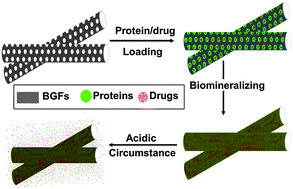Reverse-biomineralization assembly of acid-sensitive biomimetic fibers for hard tissue engineering and drug delivery†
Abstract
Biomimetic design and fabrication of tissue-engineered bone scaffolds that not only resemble natural bone in structure and performance, but also are endowed with specific functions, e.g., for drug delivery, are always an exciting research area. Herein, we report a kind of doxorubicin hydrochloride-loaded biomimetic ultrathin fiber, which is synthesized by preparing a kind of nanoporous bioactive glass fiber as a drug/protein carrier and bio-template and combining them in a reverse-biomineralization reaction. Protein adsorption experiments demonstrate that bovine serum albumin can be hosted in open large nanopores of bioactive glass fibers and the adsorption mechanism follows the intraparticle diffusion process. Biomineralization shows that proteins and drugs can be integrated at the nanoscale into minerals to form biomimetic and drug-loaded fibers, and the formation of such fibers depends on the functional ion (Ca, P, and Si) release of bioactive glass fibers and electrostatic interaction among bioactive glass fibers, proteins, and drugs. The drug-loaded composite fibers demonstrate bare homogeneous solid matrices in the fiber interior and surfaces upon which amorphous carbonated apatite resides. The drug release profiles show that the as-synthesized fibers are acid-sensitive and drugs can be released at pH 5, but not at neutral pH 7.4. Because of their structural advantages and the characteristics of acid-sensitive drug release, the biomimetic fibers have potential applications for repairing the bone defects resulting from tumour extirpation.


 Please wait while we load your content...
Please wait while we load your content...